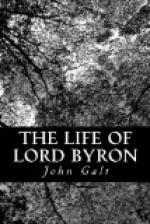The travellers wandered from one grotto to another until they came to a fountain of pure water, by the side of which they lingered some time, till, observing that their torches were wasting, they resolved to return; but after exploring the labyrinth for a few minutes, they found themselves again close beside this mysterious spring. It was not without reason they then became alarmed, for the guide confessed with trepidation that he had forgotten the intricacies of the cave, and knew not how to recover the outlet.
Byron often described this adventure with spirit and humour, magnifying both his own and his friend’s terrors; and though, of course, there was caricature in both, yet the distinction was characteristic. Mr Hobhouse, being of a more solid disposition naturally, could discern nothing but a grave cause for dread in being thus lost in the bowels of the earth; Byron, however, described his own anxiety as a species of excitement and titillation which moved him to laughter. Their escape from starvation and being buried alive was truly providential.
While roaming in a state of despair from cave to cell; climbing up narrow apertures; their last pine-torch fast consuming; totally ignorant of their position, and all around darkness, they discovered, as it were by accident, a ray of light gleaming towards them; they hastened towards it, and arrived at the mouth of the cave.
Although the poet has not made any use of this incident in description, the actual experience which it gave him of what despair is, could not but enrich his metaphysical store, and increase his knowledge of terrible feelings; of the workings of the darkest and dreadest anticipations—slow famishing death—cannibalism and the rage of self-devouring hunger.
CHAPTER XVIII
Proceed from Keratea to Cape Colonna—Associations connected with the Spot—Second-hearing of the Albanians—Journey to Marathon—Effect of his Adventures on the Mind of the Poet—Return to Athens—I join the Travellers there—Maid of Athens
From Keratea the travellers proceeded to Cape Colonna, by the way of Katapheke. The road was wild and rude, but the distant view of the ruins of the temple of Minerva, standing on the loneliness of the promontory, would have repaid them for the trouble, had the road been even rougher.
This once elegant edifice was of the Doric order, a hexastyle, the columns twenty-seven feet in height. It was built entirely of white marble, and esteemed one of the finest specimens of architecture. The rocks on which the remains stand are celebrated alike by the English and the Grecian muses; for it was amid them that Falconer laid the scene of his Shipwreck; and the unequalled description of the climate of Greece, in The Giaour, was probably inspired there, although the poem was written in London. It was also here, but not on this occasion, that the poet first became acquainted with the Albanian belief in second-hearing, to which he alludes in the same poem:




